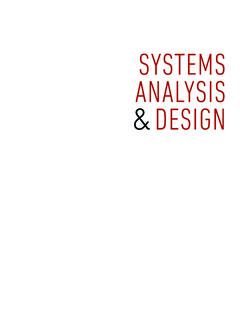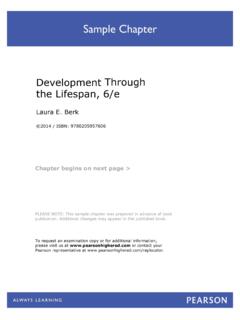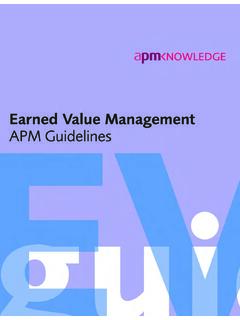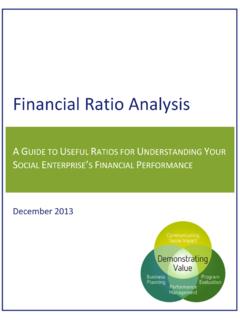Transcription of FINANCIAL STATEMENT ANALYSIS - Pearson
1 INTRODUCTION TOFINANCIALSTATEMENTANALYSISUpon completion of this chapter, you should be able to: Understand the decision emphasis of FINANCIAL STATEMENT analysisand why a comprehensive approach is needed to meet this objec-tive. Indicate who uses FINANCIAL statements and how they use them tomake decisions. Show the importance of generally accepted accounting principles(GAAP) to ANALYSIS , which organizations determine GAAP, whyGAAP differs among countries, and the benefits of harmonizingGAAP. Determine the various concepts of capital maintenance andattributes of asset measurement.
2 Articulate the benefits and limitations of the nominal dollar capi-tal maintenance concept and historical cost valuation in financialreporting and ANALYSIS . Explain how inconsistent terminology, data volume, transactioncomplexity, information variability, and FINANCIAL STATEMENT lim-itations can affect FINANCIAL STATEMENT LEARNING 8/6/01 5:54 PM Page 12 FINANCIAL STATEMENT ANALYSIS nalysts separate something whole an engine, a manufacturing process, afootball team, a presidential election, or a FINANCIAL STATEMENT into its parts.
3 They then examine the elements to find out their nature, proportion, func-tion, and interrelationship. The analytical method provides insights about howthe entirety operates, where it came from, and where it is going. FINANCIAL STATEMENT analysisis the art and science of examining the compo-nents of a company s monetary disclosures, called FINANCIAL opinions about a firm s past, present, and future operations based on theiranalysis. These beliefs guide their own actions and influence others who rely ontheir recommendations.
4 Decisions result: choices people make in allocating theirfinancial resources. The objective of this book is to help you learn how to analyze FINANCIAL aims to help you develop your ability to critically evaluate corporatefinancial representations and related information. Chapter 1 begins this processby addressing four factors: The chapter begins by presenting the requirements fora comprehensive ANALYSIS . Next, we turn to analysts objectives. The third sectioncovers the standards that govern FINANCIAL disclosures, and finally, we address dis-closure statements communicate a firm s economic events to interested do so in aggregate form by summarizing an entity s dealings with people,organizations, processes, and things.
5 In order to analyze this highly abstracted setof data, the analyst must understand the influences on FINANCIAL statements andhow to obtain information about those factors. BUSINESS ENVIRONMENTA nalysts must understand the overall economy, legal environment, political cli-mate, and cultural context in which a company does business. They also have toconsider a company s industry and its competition when judging FINANCIAL per-formance. Such insights require knowledge of business strategies, managerialpolicies, information systems, productive capabilities, labor relations, distribu-tion networks, and marketing channels, even though many of these factorsexceed the scope of the FINANCIAL statements.
6 Analysts must answer such ques-tions as these:1 This book views FINANCIAL STATEMENT ANALYSIS from a broad perspective. Anyone who uses financialstatement data to make decisions is considered a FINANCIAL analyst or FINANCIAL STATEMENT analyst for thepurposes of this text. In a narrower sense, a FINANCIAL analyst is an individual with expertise in evaluat-ing FINANCIAL investments with an emphasis on determining the risk and reward characteristics of stocksand bonds. See, for example, D. L. Scott, Wall Street Words(Boston: Houghton Mifflin, 1997), p.
7 ANALYSISWEBXERCISE 1Go online to examine Apple Computer,Inc. s FINANCIAL statements. Clickon Hot News, locate AboutApple, and click on InvestorInformation. Search SECF ilings for Form10-K andscroll through the most recentyear s Form 10-K until youlocate Item 8, FinancialStatements and SupplementaryData. Examine its 8/6/01 5:54 PM Page 2 CHAPTER 1: INTRODUCTION TO FINANCIAL STATEMENT ANALYSIS3 How sensitive are the company s activities to changes in economic conditions? Are there any legislative or regulatory initiatives pending that will affectbusiness?
8 Is the industry in which the company competes emerging, growing, or mature? Who are the firm s key competitors? Are management and the workforce well trained? Is the company planning any product introductions or market penetrations?These questions cannot be answered by directly examining a company s financialstatements; yet, such events have influenced previous corporate disclosures andaffect their forecasts. Therefore, the analyst needs to develop a comprehensiveperspective when analyzing FINANCIAL statements, or risk making poor judgmentsand bad SOURCESA broad-based approach to FINANCIAL STATEMENT ANALYSIS requires a breadth ofinformation.
9 The analyst must locate and use a variety of current and historicaldata sources to supplement the FINANCIAL data supplied by the company. Suppose,for example, you wanted to forecast earnings. Corporate income numbers are dis-closed in the FINANCIAL statements, so you might start with these data to constructan earnings trend line. Previous trends, however, do not guarantee future conditions, market shifts, competitor initiatives, and managerial deci-sions also affect future earnings. You must consider these factors, and others likethem, in a comprehensive earnings come in many forms, are found in many places, contain various benefits,and have different costs.
10 Moreover, information is fluid. One need only look to theInternet for evidence of the changing information landscape. Information caneither be primarily numerical or verbal; it also contains various degrees of objec-tivity and subjectivity. Market share data gathered by an independent party, forexample, are more reliable than those presented by someone with a vested interestin the company. Management s interpretation of those numbers is more subjectiveand qualitative than the market share data themselves. Analysts can find value inall of these information sources, provided they adjust for existing ETHICSF inancial analysts often release research reports,which provide potential investorswith the analyst s opinion about a company.
















